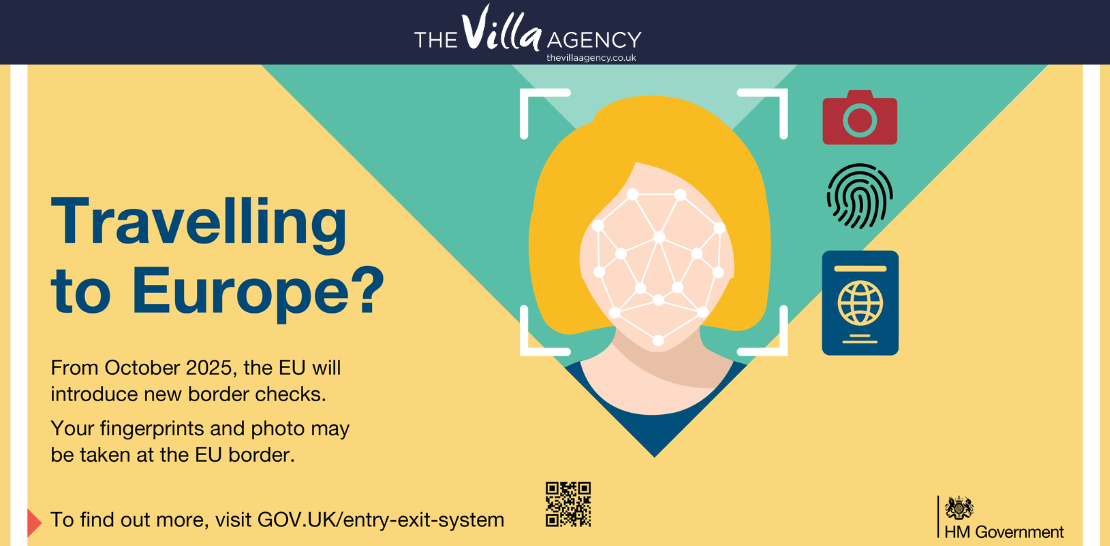
New EU Border System from October 2025: What You Need to Know
October 6, 2025
Planning a trip to Europe? There’s a new travel system you’ll want to know about.
From 12 October 2025, the European Union will launch the Entry/Exit System (EES) — a new electronic border control process for non-EU travellers (including UK citizens). Designed to make border checks more secure and efficient, the system will digitally record when and where travellers enter and exit the Schengen area.
In simple terms, it means that instead of a passport stamp, your entry and exit will be logged electronically — along with a quick photo and fingerprint scan the first time you travel. While the goal is to speed up border control in the long run, there may be slightly longer queues as the system is introduced in phases.
So, what does this mean for your European holiday? Let’s break it down.
What to Expect
✅ You will need to have your fingerprints and photo taken at the border.
✅ You may be asked routine border security questions.
✅ If travelling via Dover, Eurotunnel, or St Pancras, these checks will take place before leaving the UK.
✅ Be prepared for slightly longer border waits at first.
The rollout will happen gradually between October 2025 and April 2026, so you might experience different entry processes depending on your travel dates and destination.
Frequently Asked Questions
What is EES?
EES (Entry/Exit System) is a new digital border management system being introduced by the EU to strengthen external Schengen borders. It will record the time and place of entry and exit for non-EU travellers — including British citizens — and replace manual passport stamping.
Travellers will have their fingerprints and a facial photo taken the first time they enter the Schengen area. This process should only take a few minutes and won’t need to be repeated every time you travel.
Do I need to pay for EES?
No. EES registration is free. If anyone asks for payment, it’s likely a scam. However, a separate system called ETIAS (European Travel Information and Authorisation System) will launch later, which will require a small fee — but that’s not part of EES and isn’t expected to begin until Autumn 2026.
What countries are included in the Schengen area?
The Schengen area covers 29 countries where border checks have been removed between member states. These include:
Austria, Belgium, Bulgaria, Croatia, Czech Republic, Denmark, Estonia, Finland, France, Germany, Greece, Hungary, Iceland, Italy, Latvia, Liechtenstein, Lithuania, Luxembourg, Malta, Netherlands, Norway, Poland, Portugal, Romania, Slovakia, Slovenia, Spain, Sweden, and Switzerland.
EES does not apply when travelling to Ireland or Cyprus.
Will I need to do this every time I travel?
No. Your biometric data (fingerprints and photo) will be stored for three years, so you won’t need to repeat the process every time you travel. After that period, you may be asked to re-register.
Is there anything I can do to prepare for EES?
You don’t need to register in advance. Just make sure your passport is valid and allow extra time at border crossings — especially during the first few months of rollout. If you’re travelling with children, check your documents and plan for a few extra minutes at passport control.
Will I be delayed?
There may be slightly longer waiting times during the first few months of EES, especially at busy airports, ports, and the Eurotunnel. Once travellers have completed their initial registration, future trips should be faster.
What about children?
Children under 12 will not need to provide fingerprints, but their photo will still be taken. Parents or guardians must be present during the process.
What if I have more than one passport?
Travellers should always use the same passport when entering and leaving the Schengen area, as your biometric data will be linked to that document. Switching passports could cause delays or confusion at border control.
What is the difference between EES, ETIAS, and ETA?
It’s easy to confuse these systems, so here’s a quick guide:
-
EES (Entry/Exit System) – Starts October 2025. Digitally records travellers’ entry/exit and replaces passport stamping.
-
ETIAS (European Travel Information and Authorisation System) – Coming late 2026. A pre-travel authorisation (like the US ESTA) that non-EU visitors must apply for before entering the Schengen area. It will include a small fee.
-
ETA (Electronic Travel Authorisation) – The UK’s own system for non-UK citizens entering the UK, already being rolled out for some nationalities.
Will I need a visa to travel to the EU?
No, British citizens do not need a visa for short stays (up to 90 days in any 180-day period) within the Schengen area. EES won’t change this rule — it will simply make it easier for authorities to track stays digitally.
For further FAQs, click here.
In Summary
The new EU Entry/Exit System is part of Europe’s move toward digital border management. While it might take a little longer at first, it’s designed to make travel safer and smoother in the long run.
🔗 Read more about the new EES and which countries are affected →
As always, we’ll keep you updated as more details are confirmed. In the meantime, check your passport validity — and start planning your 2026 villa getaway early to beat the rush!

